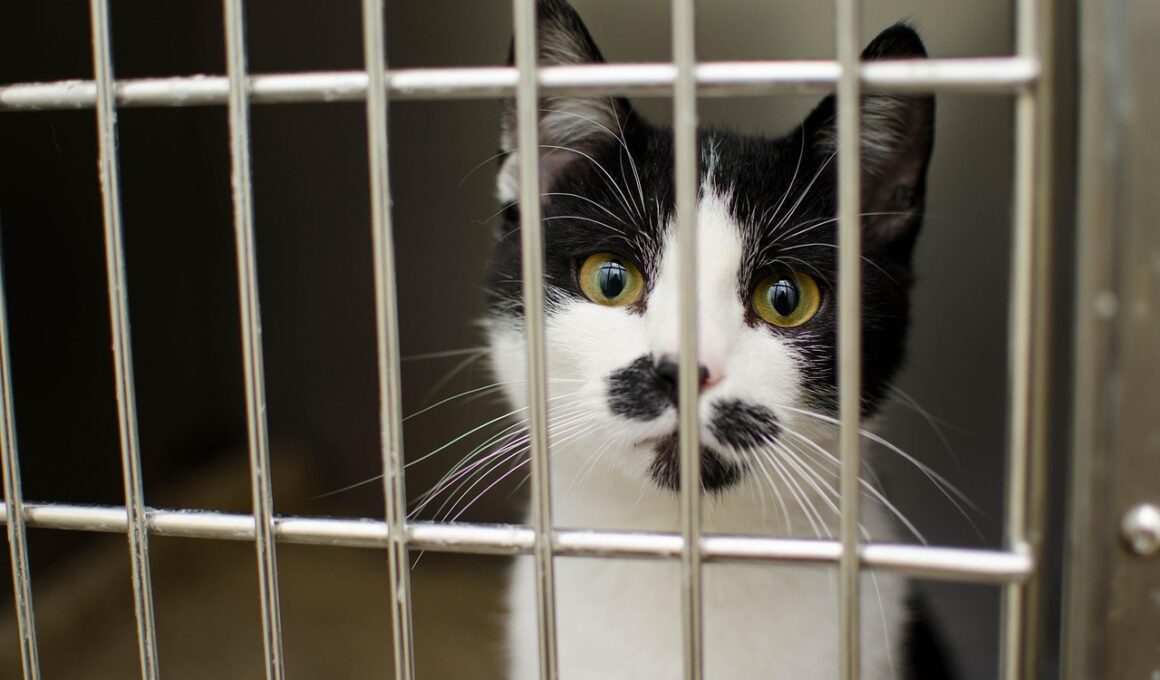Sheltering Strategies for Cats in Emergency Evacuations
In situations of natural disasters, having effective sheltering strategies for cats is paramount. Animals, especially cats, can be easily stressed during emergency evacuations, so ensuring safety and comfort is vital. When plans are made to evacuate, it’s essential to prepare in advance to reduce anxiety for both felines and their caretakers. Evacuating with cats requires a well-thought-out strategy that ensures their safety and well-being. Identifying suitable shelters that accommodate pets can significantly lessen the stress of both pets and their owners. Moreover, ensuring accessibility to necessary supplies, such as food and water, should not be overlooked. A designated emergency kit for each cat is crucial in these situations. This kit should include their favorite food, medications, litter, and any comfort items that help reduce anxiety, such as a familiar blanket. Having a reliable transport system is also necessary. It’s essential to have cat carriers ready and ensure that each cat is accustomed to their carrier to facilitate a smooth transition. By planning effectively, the chances of a safe and successful evacuation can dramatically improve.
Creating a Cat Emergency Kit
Creating an emergency kit specifically for cats can make a world of difference during a disaster. Each kit must be tailored to attend to the unique needs of your feline companions. Start by selecting durable, portable containers for easy transportation. A well-stocked kit should contain essential supplies such as id tags, food, and water, along with a first aid kit, which is crucial for addressing minor injuries. Another critical component includes medications any cats may require during emergencies. It is advisable to include comfort items that help keep cats calm, like toys or blankets they are familiar with. Moreover, remember to regularly check expiration dates on food and medications in your kit. Including a copy of vaccination records is also important, especially during evacuations, as some shelters may require proof of vaccination. If possible, creating a detailed emergency contact list, including a vet’s information, can further support your rapid response in a crisis. Lastly, practice evacuation protocols with your cats to familiarize them with the process. An emergency kit that is well-prepared can significantly enhance the safety and comfort of cats during stressful evacuation situations.
Before a disaster strikes, ensuring that your cats are comfortable in their carriers is crucial. Familiarizing them with their carriers from a young age helps ease anxiety during emergencies. Place their favorite toys or blankets inside the carriers to create a safe and welcoming atmosphere. Additionally, practice short trips with the carriers to help them associate the carriers with a positive experience. Using treats can reinforce this association as well. Marking each carrier with the cat’s name or photo can facilitate easy identification at evacuation centers. In the chaos of a disaster, clear identification helps keep cats with their owners. It can also be useful to have current photographs of your cats on hand, which can prove valuable in case they become lost. When evacuating, prioritize the safety of your cats and other pets. Always ensure they are secured in their carriers before leaving. Having a designated family member responsible for pets during evacuations can streamline your attempts to ensure their safety. By creating a consistent environment, you can alleviate some of the stress that your cats may experience during a disaster evacuation.
Understanding Shelter Protocols
Understanding shelter protocols during emergencies is essential for effectively safeguarding cats. Each shelter may have specific requirements regarding pet animals during an emergency situation. Several shelters may only allow animals if they are accompanied by their caregivers and hold appropriate documentation. Recognizing these protocols beforehand ensures that you are prepared when reaching a safe haven. Moreover, it’s wise to research the nearest pet-friendly shelters in your area well before any disasters occur. Making a plan for alternate accommodations, such as friends’ homes or hotels, offers additional options that can be explored in case conventional shelters are filled to capacity. Ensure that each cat has a valid collar or harness with a tag that contains your contact details. In some cases, microchipping your cats can serve as an extra precaution, increasing the likelihood of a reunion if they become separated. Awareness of shelter capacities and restrictions can significantly reduce confusion and anxiety in chaotic environments. Each emergency situation may differ, so stay updated with local authorities for any new information or changes regarding pet protocols in shelters and evacuation sites.
Collaboration with local animal welfare organizations can provide invaluable support during emergency evacuations. These organizations often have experience and resources to help facilitate safe transport and shelter for pets during disasters. Building connections with these groups in the community will ensure you have access to necessary supplies and assistance in emergencies. They often conduct workshops and seminars, aiding pet owners in developing better emergency plans for their cats. Collaborating with these groups may also provide resources for obtaining temporary foster homes for cats during extended evacuations. Engaging with people who share a commitment to feline rescue ensures that your community is well-prepared for disasters. Promoting awareness about the importance of having emergency plans for pets can increase preparedness and increase the number of pet-friendly shelters within the community. Participation in local planning meetings can also help elevate the visibility of pet needs during disasters. Remember, forming these partnerships can be lifesaving during an emergency. You can have peace of mind knowing that there will be additional resources and assistance available when the unexpected occurs.
Regular Veterinary Visits
Regular veterinary visits are crucial to ensuring your cat remains healthy, especially during uncertain times like disasters. Keeping your cat’s vaccinations up to date is vital for their well-being and helps comply with various shelter requirements during emergencies. Schedule routine check-ups to address health concerns proactively and obtain necessary vaccinations. Maintaining an up-to-date health record allows for quicker processing at shelters, enhancing their chances of staying with their caretakers. Cats facing health issues or potentially contagious conditions might face restrictions during evacuations, underscoring the importance of preventive care. Ensure that any medications your cat needs are noted and always easily accessible in your emergency kit. Having sufficient supplies of any required medications can make a significant difference during evacuations. Moreover, during your vet visits, consider discussing any anxious behavior exhibited by your cat during stressful situations. Your veterinarian may recommend specific tranquilizers or calming supplements that help create a smoother transport experience during emergencies. Addressing any underlying health and behavioral issues can greatly ease your cat’s experience during the stressful circumstances of an evacuation.
Post-disaster recovery for cats is crucial to restoring normalcy in their lives. It’s essential to provide them with a stable environment as they readjust after the event. Allowing them access to familiar items can help reduce anxiety. Also, maintain a consistent routine in feeding and playtimes to re-establish their sense of security. Engage in regular play activities to help alleviate stress and encourage physical activity. Monitor your cats for any behavioral changes that may arise due to trauma from the experience. Some cats might require additional attention or, in some cases, even professional behavior consultations to address any issues stemming from the evacuation. Observing their interactions with other pets or changes in appetite can provide valuable insights into their emotional well-being post-event. Building a calm and supportive environment may assist in their psychological recovery. If feasible, maintain access to veterinary care to manage any lingering health concerns. Long-term recovery may take time, but ensuring your cat feels loved and secured will significantly assist in the healing process. Remember, their resilience during crises can surprise you, but your support is vital.


